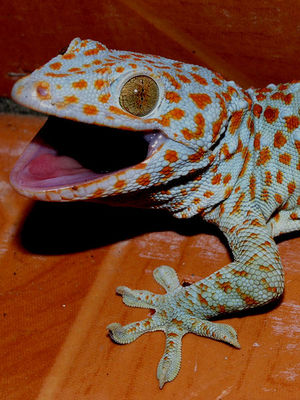Tokay Gecko
| This article has been peer reviewed but is awaiting expert review. If you would like to help with this, please see more information about expert reviewing. |
Scientific name: Gekko gecko
Description
These are relatively large geckos, 30-35cm in total length. The young are 5-7.5cm at hatching. They are heavily built with a large head and powerful jaws equipped with numerous sharp teeth capable of giving a painful bite. Tokays are slate blue in colour and evenly spotted with orange or rust. As with other geckos, the colours may lighten or darken with mood changes or in response to the diurnal pattern.
Their attractive appearance is not matched by their disposition - they are known for their nasty temperament and readily bite. They do best with a minimum of handling but when it is necessary to handle them they should be lightly but firmly grasped just behind the head.
Like many other geckos, tokays have the specialised lamellae on the pads of their toes that enable them to walk on vertical surfaces, including ceilings. These are composed of tiny, microscopic filaments, which find equally tiny imperfections in surfaces - including glass. These geckos also lack moveable eyelids. Males can be easily recognised by their angular row of preanal pores.
For sexual attraction the males have a distinctive call which can be heard over a wide area; the call is a loud "to-kay" and is repeated several times.
Range
South-eastern Asia from north-eastern India to the archipelago. They live in tropical rainforests, on cliffs and trees, and in increasing numbers amongst human habitation.
Diet
In the wild their diet consists mainly of large arthropods but other lizards and small mammals will occasionally be taken. In captivity they should be fed daily and large crickets are ideal. Zoophorbas or, for smaller tokays, mealworms can also be given for variety. Larger tokays may take locusts and pink mice. All insects should be properly nutrient-loaded for at least 72 hours before being offered.
Tokays will not drink out of a bowl of water so misting or a drip system is necessary.
Enclosure
A purpose built vivarium is ideal. Glass fronted wooden cages, with small ventilation panels below the front glass panel and on top of the cage, are also suitable. Because of the size of these animals, the height of the vivarium should not be less than 1m and the width less than 0.8m. A layer of potting compost or orchid bark several cms deep are appropriate substrates. The side and rear walls of the cage can be covered with cork tiles or bark. Stout branches and cork bark tubes or bamboo poles should be stood upright in the vivarium for climbing and basking spots. Sturdy foliage plants provide hiding places and help keep up humidity. A way to boost humidity and provide water is to place ice cubes on top of the screened top over the plants. The water drips on the plant leaves.
A simple spotlight can provide both daytime light and heat with the appropriate wattage bulb. Tokays are nocturnal species and a full spectrum/ UV light is not necessary. They remain lethargic and inactive during the daylight hours, clinging to the top and sides of their enclosure. At dusk they awaken and spend most of the evening hours active in search of food.
Temperature
The daytime temperature range should be 24-32ºC, dropping to 22-26ºC at night.
Literature Search
Use these links to find recent scientific publications via CAB Abstracts (log in required unless accessing from a subscribing organisation).
Tokay Gecko (Gekko gecko) publications

